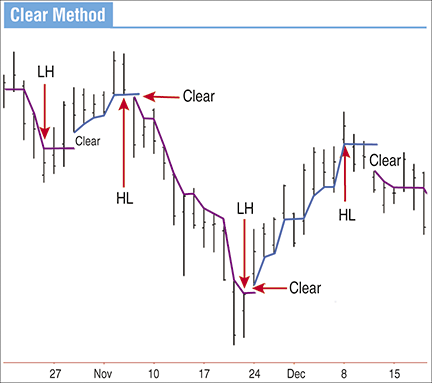SWING TRADING
When To Enter And Exit Trades
Using Noise
Price can do one of three things: Move in the direction of the swing, not move, or reverse swing direction. When the price is not moving, we have noise. Here’s how you can use that noise to help decide when to enter and exit trades.
In my September 2010 article for Stocks & Commodities, I discussed the Clear method, a way to determine the direction of short-term price swings. The method identifies the direction of the current price swing and the precise day the swing direction changes. It requires no calculation and has no delay. It is applicable to all stocks, commodities, and indexes in any time frame.
We saw how, unlike most technical indicators, the Clear method does not use the open or the close for its analysis. Instead, it uses the range of the daily price bar as the measure of price uncertainty. I looked at how price bars are simplified distributions. Since prices are distributed, we consider the price to be different only if the two distributions (price bars) do not overlap; the bars must be “clear” of one another.
Movement of the price bar
Figure 1 shows the Clear method in action, showing the up swings, down swings, and the “clears” that define the changes in direction. In this article, I will look at how the method defines the only three things price can do: move in the direction of the swing, not move, and reverse swing direction. When the price is not moving, there is noise. I will take a brief look at the noise percentage as a measure of continuous directionality. Finally, I will look at a way you can use noise to decide when to enter and exit trades.

Figure 1: THE CLEAR METHOD. When price clears below the highest low (HL), a new down swing begins. When price clears above the lowest high (LH), a new up swing begins.